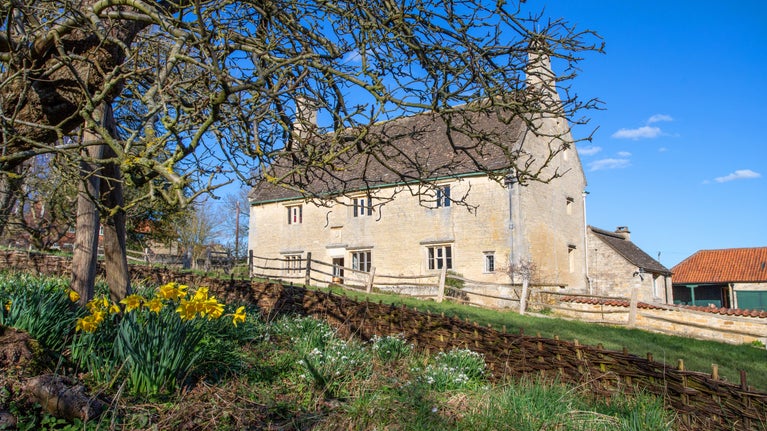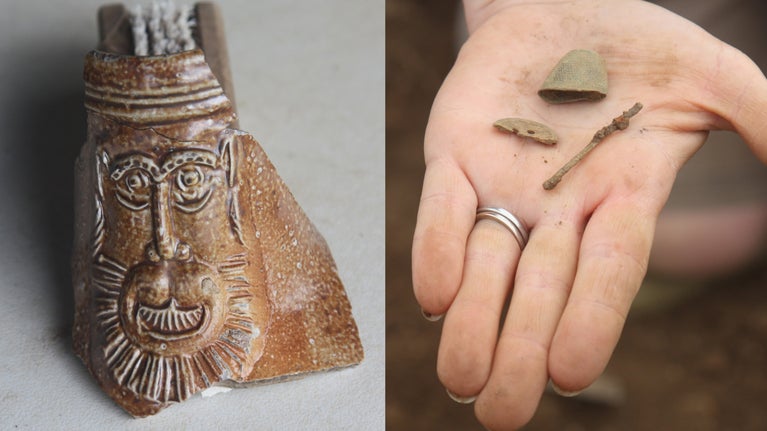
Discover more at Woolsthorpe Manor
Find out when Woolsthorpe Manor is open, how to book your visit, the things to see and do and more.

Archaeologists from the National Trust have revealed a selection of everyday objects from the site of a house built for Isaac Newton’s mother, in a field next to the famous apple tree which inspired some of his great scientific advances.
Searching for the exact location of the house, the archaeologists discovered rubble from its demolition – and intriguingly some objects which might have been in the house when the Newton family was there.
They included:
Isaac Newton was born at Woolsthorpe Manor in Lincolnshire but his father died just three months before. His mother, Hannah Newton, later moved away marrying a vicar, leaving Isaac to be raised by his grandparents at Woolsthorpe Manor.
After her second husband died in 1653, Hannah had a house built for her next door to Woolsthorpe Manor and moved in with her three children from her second marriage. Isaac, then 10-years-old, continued to live at Woolsthorpe Manor with his grandparents. Hannah Newton’s house was believed to have been demolished following a fire in the early 1800s.
It was five years ago that the National Trust acquired the field next to Woolsthorpe Manor where evidence indicated the house of Hannah once stood. A sketch from 1797 by JC Barrow showed the house, and survey work over the past few years, conducted by South Witham Archaeology Group and the University of Leicester, unearthed more evidence to justify a proper dig.
To help Trust archaeologists explore the site, the dig was opened up for families to come along and join in as part of the Festival of Archaeology. Different sessions included digging, cleaning finds and an artefact ID quiz.
National Trust archaeologist Rosalind Buck said: “The discoveries are such relatable objects and a real window into the domestic life of the Newton family. We can really imagine Hannah and the family eating from items like the Staffordshire slipware, or using jugs like the one with that magnificent, embossed face. Were people potentially gaming with jetton pieces while domestic tasks such as sewing and repairing clothes were being done nearby?”
Jennie Johns, Collections and House Officer at Woolsthorpe, said: “While some families will be heading to the beach this summer to dig in the sand, we wanted to give them a chance to dig something more historic and help us to uncover some of the lost history of Woolsthorpe. By encouraging families to discover secrets and uncover the story of this lost house we wanted to inspire the next generation and encourage them to be inquisitive about the past so that archaeology and exploration can continue to thrive.”
Some of Isaac Newton’s greatest discoveries happened at Woolsthorpe Manor when, in 1665, the plague sent him back from a closed Cambridge University to his birthplace. During 18 months of working in solitude Newton laid the foundations of much of science today, including describing laws of motion and gravitation and discovering that light was actually made up of a rainbow of colours.
The National Trust archaeologists were helped by a team from York Archaeology for the excavations to find Hannah’s house over the ten days of digging.
Laura Parker, Community Project Officer for York Archaeology, said: ‘Uncovering and rediscovering stories of the past as we dig down is always a fascinating process, but even more so when you are looking for something connected to one of the best-known scientists of all time, Sir Isaac Newton. This is a great opportunity for families to see what happens on a dig, and how archaeologists carefully peel back layers of the past to discover more about the history beneath our feet - and even get involved in the process for themselves. For any budding archaeologist, having an early experience of a real dig in such a significant site can sow the seed for a lifelong interest or career - and what a way to start!’
Once cleaned and prepared, some of the finds will go on display at Woolsthorpe Manor next year, in a display about the lost house.

Find out when Woolsthorpe Manor is open, how to book your visit, the things to see and do and more.